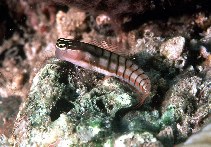| Family: |
Blenniidae (Combtooth blennies), subfamily: Salariinae |
| Max. size: |
3.1 cm SL (male/unsexed) |
| Environment: |
reef-associated; marine; depth range 1 - 34 m |
| Distribution: |
Western Pacific: known only from the Philippines. |
| Diagnosis: |
Dorsal spines (total): 12-12; Dorsal soft rays (total): 12-13; Anal spines: 2-2; Anal soft rays: 14-15; Vertebrae: 31-32. Description: Dorsal fin XII,12-13 (usually 13), with deep notched between spinous and segmented-ray portions; anal fin II,14-15 (usually 15); pectoral rays 12-14 (usually 13); pelvic I,3; caudal fin 13. Vertebrae 10 + 20-22 (usually 21). Incisors and canines look very similar, 39-44; posterior canines one on each side; posterior canines usually one on each side. Lateral line without pores, terminates below dorsal-fin spines between 9-11. Anterior nostril with cirrus on posterior rim only. Head pinstripes whitish or yellow, three, parallel, short; head pinkish to brownish and paler below the pinstripes; without markings on ventral surface and opercle margin. Body overall grey, darker dorsally, either with black narrow stripes and faint gray bands; or with two orange to brownish broad stripes interrupted by 8-9 broadly interspaced intensely dark bands below the dorsal fin spinous and segmented-rays portion (Ref. 5296, 90102). Body depth 4.5-5.5 in SL, at origin of anal-fin (Ref. 90102). |
| Biology: |
Found in coral reefs (Ref. 90102), sand, rubble and coral bottoms (Ref. 5296). Oviparous. Eggs are demersal and adhesive (Ref. 205), and are attached to the substrate via a filamentous, adhesive pad or pedestal (Ref. 94114). Larvae are planktonic, often found in shallow, coastal waters (Ref. 94114). |
| IUCN Red List Status: |
Least Concern (LC); Date assessed: 25 March 2009 Ref. (130435)
|
| Threat to humans: |
harmless |
Source and more info: www.fishbase.org. For personal, classroom, and other internal use only. Not for publication.

